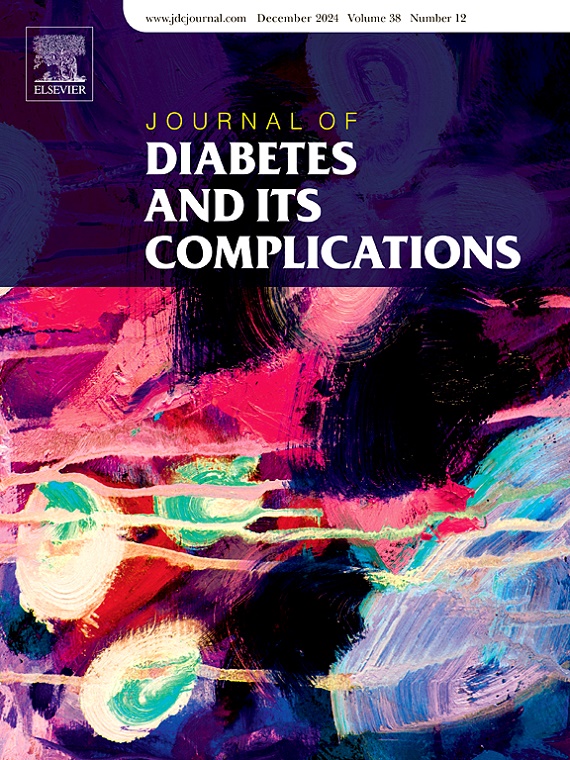Effects of empagliflozin and dapagliflozin, SGLT2 inhibitors, on miRNA expressions in diabetes-related cardiovascular damage in rats
IF 3.1
3区 医学
Q3 ENDOCRINOLOGY & METABOLISM
引用次数: 0
Abstract
Type 2 diabetes mellitus (T2DM) has become a global health concern due to its rapidly increasing prevalence and associated complications. Empagliflozin and dapagliflozin, sodium-glucose co-transporter 2 (SGLT2) inhibitors, have widely used in the management of T2DM. Moreover, empagliflozin and dapagliflozin reduce the risk of cardiovascular events and associated mortality both with and also without diabetes. In the present study, it was investigated empagliflozin and dapagliflozin effects on miRNA expression in nicotinamide/streptozotocin-induced T2DM rats. The male/female rats were divided into four groups: Control, T2DM, T2DM + Empagliflozin, and T2DM + Dapagliflozin. The body weights were monitored weekly and blood pressure measurement were evaluated first and last week. IL-1β, SOD, RAGE, and cTnI levels in serum and heart tissue were detected by ELISA. The RT-PCR was used to analyze the expression levels of miRNAs in the heart tissue of diabetic rats. As a result, the most remarkable findings miR-223, miR-373, miR-22, miR-9, miR-146a, miR-21, miR-144, miR-221, and miR-34a had significantly higher expressions in the control group. Moreover, miR-146a and miR-34a levels are remarkably increased empagliflozin group comparison to the T2DM group. The miR-146a expression was increased dapagliflozin group comparison to the T2DM group. Additionally, treatments with empagliflozin and dapagliflozin showed improvements in histopathological and biochemical examinations.

SGLT2抑制剂恩格列净和达格列净对糖尿病相关心血管损伤大鼠miRNA表达的影响
2型糖尿病(T2DM)已成为一个全球性的健康问题,由于其迅速增加的患病率和相关并发症。恩格列净和达格列净是钠-葡萄糖共转运蛋白2 (SGLT2)抑制剂,已广泛用于T2DM的治疗。此外,恩格列净和达格列净可降低伴有和不伴有糖尿病的心血管事件和相关死亡率的风险。本研究研究恩格列净和达格列净对烟酰胺/链脲佐菌素诱导的T2DM大鼠miRNA表达的影响。将雄性/雌性大鼠分为4组:对照组、T2DM组、T2DM +恩帕格列净组、T2DM +达帕格列净组。每周监测体重,第一周和最后一周评估血压。ELISA法检测血清和心脏组织中IL-1β、SOD、RAGE、cTnI水平。采用RT-PCR方法分析糖尿病大鼠心脏组织中mirna的表达水平。结果,最显著的发现是miR-223、miR-373、miR-22、miR-9、miR-146a、miR-21、miR-144、miR-221和miR-34a在对照组中表达量显著升高。此外,与T2DM组相比,恩格列净组miR-146a和miR-34a水平显著升高。与T2DM组相比,达格列净组miR-146a表达升高。此外,恩格列净和达格列净治疗在组织病理学和生化检查方面均有改善。
本文章由计算机程序翻译,如有差异,请以英文原文为准。
求助全文
约1分钟内获得全文
求助全文
来源期刊

Journal of diabetes and its complications
医学-内分泌学与代谢
CiteScore
5.90
自引率
3.30%
发文量
153
审稿时长
16 days
期刊介绍:
Journal of Diabetes and Its Complications (JDC) is a journal for health care practitioners and researchers, that publishes original research about the pathogenesis, diagnosis and management of diabetes mellitus and its complications. JDC also publishes articles on physiological and molecular aspects of glucose homeostasis.
The primary purpose of JDC is to act as a source of information usable by diabetes practitioners and researchers to increase their knowledge about mechanisms of diabetes and complications development, and promote better management of people with diabetes who are at risk for those complications.
Manuscripts submitted to JDC can report any aspect of basic, translational or clinical research as well as epidemiology. Topics can range broadly from early prediabetes to late-stage complicated diabetes. Topics relevant to basic/translational reports include pancreatic islet dysfunction and insulin resistance, altered adipose tissue function in diabetes, altered neuronal control of glucose homeostasis and mechanisms of drug action. Topics relevant to diabetic complications include diabetic retinopathy, neuropathy and nephropathy; peripheral vascular disease and coronary heart disease; gastrointestinal disorders, renal failure and impotence; and hypertension and hyperlipidemia.
 求助内容:
求助内容: 应助结果提醒方式:
应助结果提醒方式:


